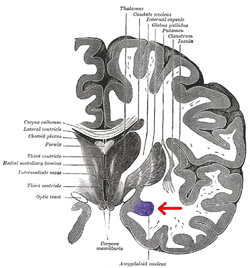| Basolateral amygdala | |
|---|---|
 Coronal section of brain through intermediate mass of third ventricle. Amygdala is shown in purple. | |
| Details | |
| Part of | Amygdala |
| Identifiers | |
| Acronym(s) | BL |
| NeuroNames | 244 |
| NeuroLex ID | BIRNLEX:2679 |
| FMA | 84609 |
| Anatomical terms of neuroanatomy | |
The basolateral amygdala, or basolateral complex, consists of the lateral, basal and accessory-basal nuclei of the amygdala. The lateral nuclei receives the majority of sensory information, which arrives directly from the temporal lobe structures, including the hippocampus and primary auditory cortex. The basolateral amygdala also receives dense neuromodulatory inputs from ventral tegmental area (VTA),[1][2] locus coeruleus (LC),[3] and basal forebrain,[4] whose integrity are important for associative learning. The information is then processed by the basolateral complex and is sent as output to the central nucleus of the amygdala. This is how most emotional arousal is formed in mammals.[5]
- ^ Mingote S, Chuhma N, Kusnoor SV, Field B, Deutch AY, Rayport S (December 2015). "Functional Connectome Analysis of Dopamine Neuron Glutamatergic Connections in Forebrain Regions". The Journal of Neuroscience. 35 (49): 16259–16271. doi:10.1523/JNEUROSCI.1674-15.2015. PMC 4682788. PMID 26658874.
- ^ Tang W, Kochubey O, Kintscher M, Schneggenburger R (May 2020). "A VTA to Basal Amygdala Dopamine Projection Contributes to Signal Salient Somatosensory Events during Fear Learning". The Journal of Neuroscience. 40 (20): 3969–3980. doi:10.1523/JNEUROSCI.1796-19.2020. PMC 7219297. PMID 32277045.
- ^ Giustino TF, Maren S (2018). "Noradrenergic Modulation of Fear Conditioning and Extinction". Frontiers in Behavioral Neuroscience. 12: 43. doi:10.3389/fnbeh.2018.00043. PMC 5859179. PMID 29593511.
- ^ Crouse RB, Kim K, Batchelor HM, Girardi EM, Kamaletdinova R, Chan J, et al. (September 2020). Hill MN, Colgin LL, Lovinger DM, McNally GP (eds.). "Acetylcholine is released in the basolateral amygdala in response to predictors of reward and enhances the learning of cue-reward contingency". eLife. 9: e57335. doi:10.7554/eLife.57335. PMC 7529459. PMID 32945260.
- ^ Baars BJ, Gage NM (2010). Cognition, Brain, and Consciousness: introduction to cognitive neuroscience (second ed.). Burlington MA: Academic Press.
© MMXXIII Rich X Search. We shall prevail. All rights reserved. Rich X Search
